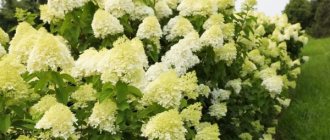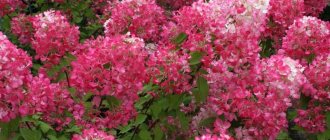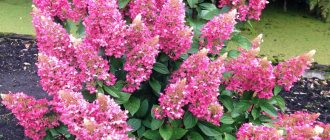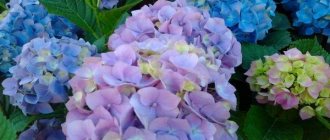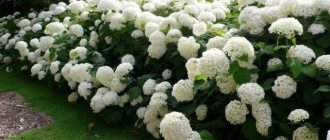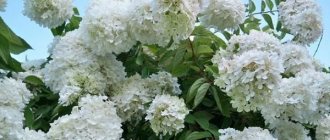Hydrangea paniculata variety Vanilla Fraise® (Vanilla Strawberry) 'Renhy' (Strawberry and Cream) is a new deciduous shrub grown for landscape use, characterized by large inflorescences (120x170 mm) of sterile flowers, the inflorescences turn white in mid-summer, changing color to pink after 2 weeks, then to red or burgundy (depending on night temperature). The red color lasts for 3-4 weeks. The leaves are oval, light to medium green in color with a rough feel on top.
Hydrangea paniculata 'Renhy' A vibrant and beautiful flowering shrub, especially because of its interesting color changes. Used as a sample for group and mass plantings, hedges, and floristry.
Hydrangea paniculata Vanilla Fraze blooms in wide pyramidal panicles from mid-July to mid-October in France. The color lasts for 4-6 weeks before darkening. The size of the bush is 2.5 m high and 1.5 m wide.
Hydrangea Vanilla Fraze 'Renny' can be compared to 'Grandiflora' (not patented) and 'Pinky Winky' (not patented). 'Grandiflora' also has large white flowers, however - all are fertile, the flowers are pink only for a short period of time. 'Pinky Winky' also has white flowers that turn pink and red for only a short period of time.
Origin
The new hydrangea variety resulted from a controlled propagation program that began in 1987 (Garrone, France), with the goal of producing a selection of hydrangeas that bloomed early in the season with red, sterile flowers. The inventors began the breeding program by selfing Hydrangea paniculata 'Unique' (not patented), the parents of 'Renhy' being unnamed private seedlings produced after seven series of subsequent crosses. In 2002, Hydrangea 'Renhy' was selected as the only unique plant among the progeny (Garron, France).
The new variety was first propagated from cuttings in May 2003 by the inventors in Garron, France. The characteristics of the new variety were determined to be stable and reproduced according to type in subsequent generations.
The Vanilla Fraze hydrangea variety was introduced by Bailey Nurseries in 2009.
Patent number PP20670, Inventors: Jean Renault, Thierry Renault, Eric Renault.
History of selection
Hydrangea paniculata (Hydranges Paniculata Vanille Fraise) has several names:
- Rennie;
- Vanilla Fries;
- Vanilla Frazee;
- Vanilla Fries.
The variety was bred in the French flower nursery Pepinieres Renault. Work on its creation began in 1989 and lasted almost 15 years: the variety was finally obtained in 2003, as stated by the head of the research group, Eric Renaud.
Initially, breeders set the task of obtaining a flower that could change its color. The first varieties produced white and brownish flowers. Researchers then developed many other varieties that change colors depending on weather conditions.
Hydrangea paniculata was named Vanilla Fries (translated as “vanilla strawberry”): the inflorescences have a complex color, in which white alternates with pink.
Lush hydrangea flowers Vanilla Fries look spectacular anywhere in the garden.
Subsequently, the culture spread throughout European countries. Hydrangea has repeatedly won exhibitions held in Holland and France.
Landing
The shrub grows best in moist, well-drained, humus-rich soil in sun or partial shade. For planting, soil with a pH of 6.1-6.5 (slightly acidic) to 6.6-7.5 (neutral) is suitable.
The best time to plant Vanilla Fraze is in late fall, when Hydrangea paniculata goes into dormancy, or in the spring, before rapid growth begins.
You can add compost to enrich poor soil. Before transplanting the seedling, you need to dig a hole as deep as the root ball and 2-3 times wider. Place the plant in the hole and fill it halfway with soil, water it, and after absorbing the water, fill the rest of the hole with soil. Water thoroughly.
Place several hydrangeas at a distance of 1-3 m. The plant will begin to bloom a year or two after planting.
Trimming
Hydrangea Vanilla Fraise® 'Renhy' is a variety of paniculata hydrangea that blooms on the current year's shoots. Avoid pruning once flower buds appear in the spring. Light pruning can be done after the plant has finished flowering, but pruning should be done in late winter or early spring. The general rule is to prune no more than 1/3 of the plant during the season.
Interesting facts about paniculate hydrangeas
Hydrangea paniculata belongs to the genus Hydrangea and the Hydrangeaceae family. Under natural conditions, these beautifully flowering perennials can be found on the Japanese islands, in most provinces of China, as well as in the southern part of Sakhalin Island.
Interesting! This beautiful perennial was cultivated many decades ago and is currently actively used by landscape designers when creating various park compositions. And gardeners are happy to grow various varieties of paniculate hydrangeas in their gardens.
Distinctive features of these plants:
- this tree or bushes reach a height of 1.5 to 10 m;
- the root system is not deeply buried, but their diameter exceeds the size of the hydrangea crown;
- hydrangea foliage is oval and can reach 10-12 cm in length;
- the flowers are collected in pyramidal paniculate inflorescences, the length of which is about 24 cm;
- flowers of two types: sterile, the size of which can be over 2 cm, the color of the petals is white with a green tint and gradually changes to pink; small, from which fruits subsequently appear; the petals on such flowers fall off quickly;
- fruits are boxes containing a lot of small seed material; when ripe, the box cracks in the upper part;
- The first buds appear on this flowering perennial 4-5 seasons after the seedlings are planted in a permanent place.
This is interesting! Hydrangea seeds have almost 100% germination rate.
Care
Hydrangea Vanilla Fraze is quite easy to care for, the shrub is frost-resistant in USDA 4, suitable for growing in the Moscow region, Moscow or St. Petersburg.
Diseases and pests. No susceptibility or resistance to diseases or pests was found.
During the first year or two after planting outdoors and during droughts, make sure hydrangeas receive enough water. Leaves wilt if the soil is too dry.
Soil rich in humus and containing many nutrients does not need to be fertilized. Light or sandy soil is best fertilized once a year in late winter or spring. Too much fertilizer promotes leaf growth at the expense of flowering.
For colder regions in the fall, cover the plant to a height of at least 50 cm with bark, leaf mulch, pine needles or straw. If possible, make cages out of chicken wire and fill the cages with leaves. (Do not use maple leaves)
Preparing for winter
A perennial shrub can grow in one place for many years. Therefore, an important stage of care is the annual preparation of hydrangea for wintering. Vanilla Fraze belongs to the category of winter-hardy varieties. The description of the variety indicates that it can withstand frosts down to -35°. High winter hardiness allows the variety to be planted in regions with low winter temperatures.
In order not to lose the shrub in winter, it is necessary to prepare the plant and the soil around it. Before wintering, paniculate hydrangea is pruned in a targeted manner: damaged shoots are removed, but skeletal branches are always left behind.
Creating a shelter for hydrangea involves taking successive steps:
- The tree trunk circle is hilled high and covered with dry soil.
- The bush is wrapped in non-woven material. To secure the material, use tape or rope.
- The frame is made of wooden boards or metal mesh. They surround the bush with a frame and secure the structure with available materials.
- The internal space between the bush and the frame is filled with dry leaves or pine needles.
This is an air-dry way to preserve paniculate varieties in harsh winters. A shelter is constructed only when the air temperature drops below 0°. If you cover the hydrangea too early, then there is a risk of rotting of the root system and the above-ground part of the crop.
In regions where winter air temperatures do not fall below 0°, it is enough to trim the bush, mulch the soil around it and hill up the tree trunk.
Reproduction
Hydrangea Vanilla Fraze can be propagated by cuttings; rooting lasts approximately 2 weeks in the summer in greenhouse conditions without additional lighting.
To reproduce, you need to find a newly grown shoot that has not bloomed. The new shoot will be lighter than the old one and the stem will not be stiff.
From the tip of the branch, move 10-15 cm down and make a horizontal cut. Make sure that the cut cuttings have 3-4 pairs of leaves.
Remove the bottom pair of leaves from the cutting, cutting flush with the stem. Roots grow more easily from leaf nodes, so more than one pair of leaves can be removed. It is required to retain at least 2 pairs of leaves at the end of the cutting.
If the remaining leaves are quite large, cut in half, removing half the tip. This will prevent leaves from getting on the sides of the plastic bag that will be placed over the cutting (to retain moisture).
(Optional) Sprinkle the leafless part of the stem with rooting hormone and antifungal plant powder (both available at garden centers). The drugs will stimulate rooting and prevent rotting.
Prepare a small pot and fill it with moistened substrate. Plant the cutting in the soil, lowering it to the first pair of remaining leaves. Water lightly to get rid of any air gaps around the stem.
Cover the pot with a plastic bag. Make sure that the bag does not touch the leaves of the cutting, otherwise the leaves may rot. (Chopsticks can be used to prop the bag up over the leaves.)
Place the pot in a warm place, protected from direct sunlight and wind.
Check the cutting every few days to make sure it is not rotting, next watering after the top layer of soil has dried out. The cutting should take root in a few weeks! (Check, gently pull the cutting, if resistance is felt, roots have formed.)
Possible diseases and pests, ways to get rid of them
Hydrangeas are often attacked by the following insects:
- Aphid. Insect infestation can be detected when there are clutches of eggs on the inside of the leaf blade, which bends inward. To destroy pests, the plant is treated with insecticides: Fitoverm, Bison, Iskra.
- Spider mite. The insect forms a light, poorly visible web on the leaves. Having discovered it on a bush, gardeners recommend treating it with a solution of laundry soap.
Plant diseases that can cause its death:
- Gray rot. It manifests itself in the form of watery tissue, softness of the leaf plate and the presence of a gray coating. The fight against the disease consists of completely destroying the affected part of the plant. Then they are treated three times with special agents at three-week intervals.
- White rot. At the initial stage, the root system begins to die, which does not receive enough nutrients. A sign of damage is the appearance of a white coating on young shoots. If detected early, the shrub must be treated with fungicides.
- Fusarium. It affects the root system, which gradually rots and softens. Gradually, the disease spreads to parts of the plant located above the ground. The leaves wither, fall and turn yellow. Bushes affected by the fungus are treated with targeted drugs. The root area is shed with Rovral solution.
How to cut and store dried flowers
Use dried hydrangea flowers to create a wreath or other home decorations:
- Trim the flower heads when the flowers are ripe.
- Remove leaves from stems and hang flower heads down in a warm, dry, dark, airy room.
- Once completely dry (usually a couple of weeks), store in a dry place away from direct sunlight.
- To improve the color of the flower, you can dye the inflorescences with diluted fabric dye.
Use in bouquets
- Place freshly cut hydrangea stems immediately in cold water to prevent wilting.
- Remove the lower leaves on the stems.
- Arrange the stems in a vase and place in a cool place.
- Change the water in the vase daily and spray the flowers with water.
- Soak wilted flowers in cool water for 10 to 15 minutes to revive them.
Peculiarities
The unpretentiousness of the variety and the decorative nature of large inflorescences of different shades make Vanilla Fraze deservedly popular. Hydrangea has been awarded several awards at international competitions for the richness and simultaneous variety of shades of inflorescences and the beauty of color transitions.
Interestingly, the pink-white hue of the inflorescences changes to blue-blue if desired. To do this, two months before flowering, the bushes are watered 3-4 times with an alum solution, 100 g per 10 liters of water, at intervals of 12-15 days. At the same time, they monitor the acidity of the soil, preventing it from decreasing.
Among indoor plants, Vanilla Fraze takes pride of place. They form standard bushes, about 1 m in height. When the bush sheds its leaves in the fall, the pot is put away for the winter in a cool room, with a temperature of no more than 6 degrees Celsius. At the end of February, the flower is placed in diffused sunlight. On the balcony, hydrangea blooms magnificently until September.
Reviews
July 25, 2022 BeeBopp. I planted Vanilla Fraze hydrangea last fall in a sunny place, the bush blooms beautifully in white, which changes to pink. It worries me that the bush has not grown at all since planting. Limelight hydrangeas have been growing by leaps and bounds since their first year. USDA zone 6.
September 5, 2016 Moira_French. I planted two bushes in zone 7A about 7 years ago in the midday sun. Each year the inflorescences turn white at first and turn brown without any pink color. I don't know what it takes to get the beautiful colors you see in the photo.
March 15, 2016 smcatl. The bush has been growing for the second year, strong, and even coped with a slight drought. Blooms for a few weeks each year, but not a hint of pink.
August 2, 2012 randijo55. I liked the Vanilla Fraze variety. I have 3 bushes. Shoots with inflorescences grow quickly and droop slightly, possibly due to youth. I'm looking forward to next year to see how the hydrangeas hold up through our stormy winter! Zone 5b.



